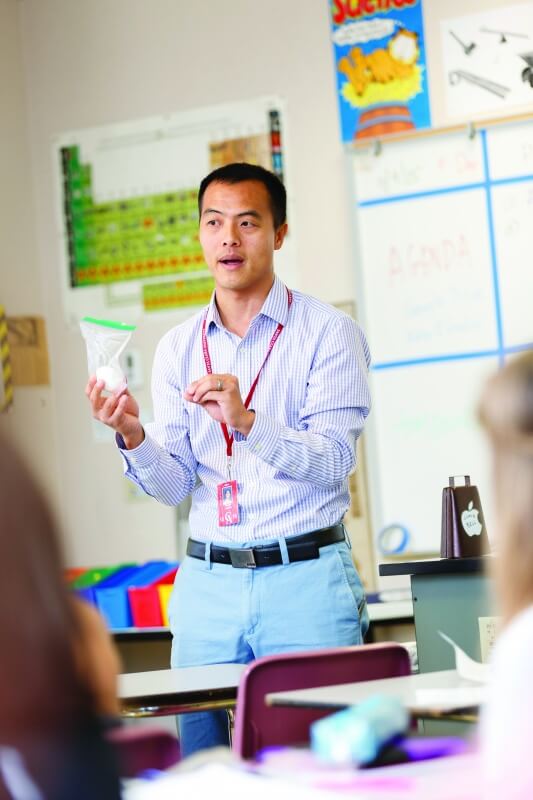There’s a critical need for STEM-savvy students to enter the U.S. workforce, and Thanh Luong plans to do his part to train them. Luong, the new eighth-grade science teacher in the Middle School, is implementing a new curriculum that promotes STEM education activities. He’ll focus on innovation, engineering, computer science and programming — as well as encourage collaboration among students so they can learn to resolve different points of view in solving problems with a scientific or technical class project.
“There’s more focus on innovation,” Luong says. “We’ll do a lot more with technology, such as 3-D printers, Google Drive, iPads, and lots of different apps that enable students to interact with each other. And there’s a lot of collaborating inside the classroom.”
The tragic earthquake in Nepal prompted an idea: Teach students how to plan a rescue operation, such as using helicopters and cargo planes to drop food and water to those in need.
“How do you drop these things meant to help them?” Luong asked his students. “Now, we need to create a parachute.” So students studied parachutes with different approaches, such as aerodynamics, drag, and parachuting applications for recreational, industrial and military purposes.
The students shared their ideas, and Luong next guided them to the design process — “What should the shape look like, what the harness should look like and more,” he said.
The students created prototypes, attached action figures to them, then dropped them from about 15 feet from a staircase at the back of the school library. “They learned the difference between speed and velocity, and that brought in mathematics,” Luong says. Then he challenged them to design a parachute that would provide a safe landing for its passenger — an egg. “They had to make sure when the egg hits the target, it can’t be cracked or open in any way,” he says. “It was a really neat challenge. It makes it more real life.”
“We’re a great school, but we’re going to push to be even better, supporting teachers to take risks, go to professional development, try new things in the classroom, whether they failed or were successful. I feel very supported that way.”
He imposed a weight limit of 100 grams, taking in both parachute and cargo. “They had to be real innovative in how they could cushion the egg. The students utilized heavy-duty trash bags, kite string, yarn, rubber bands and other materials to meet the challenge.
This allowance for innovative thinking is part of what drew Luong to Colorado Academy. “I think a lot of it has to do with the culture of the school when I visited, and the leadership, which I’m very confident in.”
He came from the Bay Area of California, where he worked in both public and private schools. “At this point in my life, when I came to interview, I saw a lot of things I really liked, and was on board with what the school is doing.
It seems to be a very progressive school that’s able to maintain its traditions. What I saw was, “We’re a great school, but we’re going to push to be even better, supporting teachers to take risks, go to professional development, try new things in the classroom, whether they failed or were successful. I feel very supported that way.”
He has 21-month-old twin sons and says, “I will do absolutely everything I can to send my kids to this school.”
Says Bill Wolf-Tinsman, Principal of the Middle School, “Having Thanh gives the school an opportunity to move our science program towards a greater STEM orientation and give a hands-on chance for kids to get excited about and develop their science skills.” Other key points from Luong:
- He plans to teach students how to program Sphero, the robotic ball, leading into Lego robotics. “I’ll have them create programs and create a robot that can do tasks,” he says. “We’re going to have a team that will build a course for Sphero and the Lego robotics.” For example, he’ll challenge students to build a robot that has an arm, hook or clamp to pick up items, take them elsewhere, then drop them.
- It’s OK to fail in his classes. “I encourage them to break out of their shell; they don’t have to be perfect. Just fail; it’s OK. Mark Zuckerberg didn’t get Facebook perfect the first time. We allow them to make mistakes; 13- and 14 year-olds are concerned with how they look to others; they’re sensitive about it.”
- And Luong is big on collaboration. “Groups may disagree on how to approach a project,” he says. “That’s the whole point of it. I want that conflict to happen.
- “It’s good for kids to have that conflict, learn how to communicate with each other. The kids are really good about listening. When someone gives an idea, we agree and say, ‘That’s a good idea, AND we can do this’ and come up with a new idea. And, ‘How about we do this?’ That’s better than rejecting it and saying that ‘My idea is better.’”
